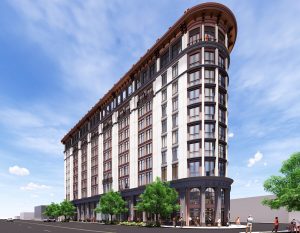There are a number of “entrances” to the City of Charleston, and since we tend to be mindful of appearances, close attention must be paid to what goes there. Case in point: at the Northbridge entrance in West Ashley, a developer proposed a massive gas station. It didn’t go well.
The northern entrance to the City is in the Upper Peninsula, where the three main north-south thoroughfares diverge into Downtown Charleston. Much of the area is underutilized as warehouse space or parking lots, such as the spot where Meeting Street diverges from Morrison Drive (which becomes East Bay Street): a triangular lot home to a derelict structure and an old gas station sign, currently used for overflow parking for nearby businesses.

Charleston’s northern entrance – and the Upper Peninsula in general – has been juggling ideas for revitalization for some time, and this centerpiece spot in particular now has a firm vision. Enter the Montford Group – a local development firm – which has presented plans to develop a hotel on this parcel that harkens a century-old model of building on triangular lots: the flatiron building design.
A History of Flatiron Buildings
Building construction in the late 1800s experienced a revolutionary transition from masonry and wood structures to the entirely new paradigm of steel frames. In the decades that followed, the built landscape of American cities transformed.
Steel structures allowed for virtually limitless design motifs, thereby enabling so many awkwardly shaped but valuable parcels to maximize coverage of their building footprints.
Where city streets intersect at odd angles, wedge-shaped buildings have become points of architectural intrigue. Often called “flatiron buildings,” their name derives from their resemblance to an old cast iron clothes iron.
New York City
Perhaps the most iconic wedge-shaped building resides at 175 Fifth Avenue in Manhattan, aptly named the Flatiron Building. The original 1902 structure was named The Fuller Building in honor of George Fuller, a proponent of steel construction who came to be regarded as “the inventor of modern skyscrapers.”
She stands today as a beautiful 22-story landmark between Fifth Avenue as it diverges from the diagonal of Broadway.

Atlanta
Our big sister city is home to a flatiron building that precedes the famous Manhattan structure, residing at the intersection of Peachtree and Broad Streets. Constructed in 1897, the English-American Building enjoys the title of Atlanta’s oldest standing skyscraper.
Boston
Another big-sister city of ours is home to a few flatirons, perhaps most iconic being the Bulfinch Building in the West End of Boston. Charles Bulfinch was known as the father of American architecture, so this 1904 building stands proud today in his honor. The structure is now home to The Boxer Hotel, which pays homage to its designer by way of Bulfinch Social, a brasserie on the ground floor.
San Francisco
Its predecessor, an earlier flatiron, was deemed “earthquake and fire proof,” but in the 1906 earthquake it succumbed to both. Two years later the steel frame replacement of The Phelan Building in San Francisco’s Financial District became an architectural icon of the west coast.
Charleston
Somewhat reminiscent from the same era but not quite: the People’s Building became Charleston’s first “skyscraper.”
Built in 1911, the awkwardly placed structure was part of an effort in the early 1900s to modernize the city, with the goal of pulling the City out of the decades-long post-Civil War depression.
The steel frame building was certainly fancy at the time – though then at it does now, does stand out among the surrounding architecture of the Historic District.
The Montford Building
The Montford Group made a successful bid to the City to rezone the parcel at the City’s northern entrance to include the property in the Accommodations Overlay, allowing for the operation of a hotel on the site. Their principal client is Thompson Hotels, with plans to construct a ten-story wedge-shaped structure at the convergence of Meeting Street and Morrison Drive.
As proposed, The Montford Building will offer ground floor amenities for visitors and locals alike, including a restaurant and bar in the wedge facing north of the City. The ground floor will also house a separate café, and on the rooftop another restaurant and pool lounge with a terrace.
Its 191 rooms along with ample meeting and event space will be a welcome addition to the underutilized entrance to the Charleston peninsula.



Renderings Courtesy of The Montford Group






